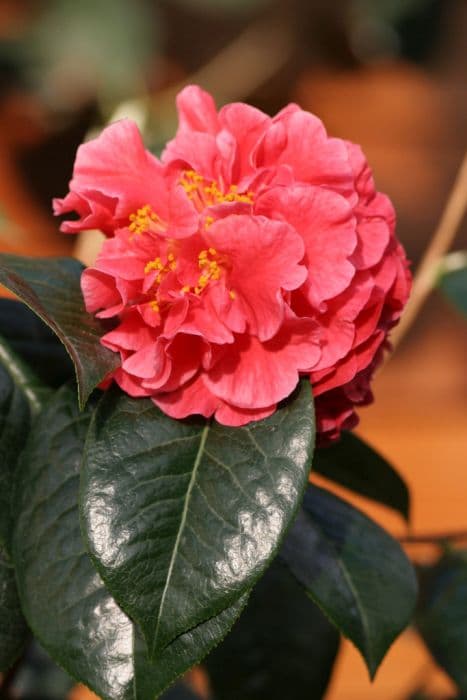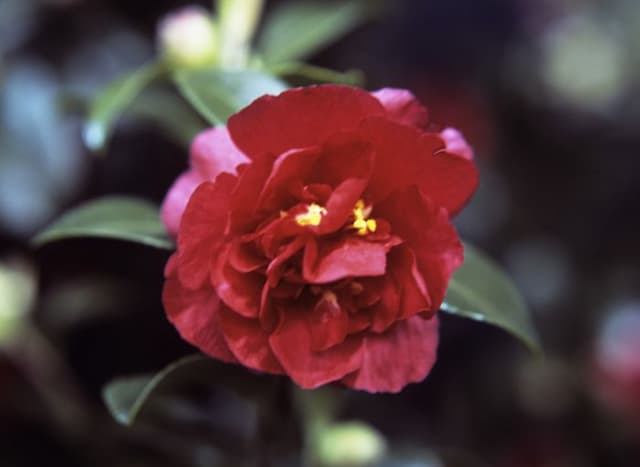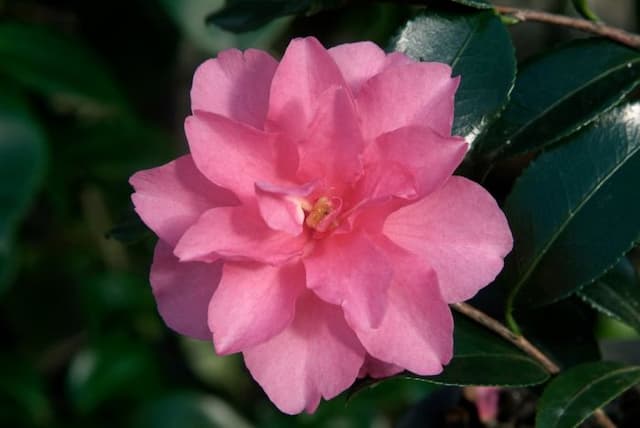Camellia 'November Pink' Camellia × williamsii 'November Pink'

ABOUT
'November Pink' is an early-flowering, rounded to broadly columnar variety. Small, pink to carmine red single flowers with 8 petals and around 6-8cm in width, appear from November through until March.
About this plant
 Names
NamesFamily
Theaceae
Synonyms
Williamsii Camellia, November Pink Camellia
Common names
Camellia × williamsii 'November Pink'.
 Characteristics
CharacteristicsLife cycle
Perennials
Foliage type
Evergreen
Color of leaves
Dark green
Flower color
Pink
Height
6-8 feet (1.8-2.4 meters)
Spread
6-8 feet (1.8-2.4 meters)
Plant type
Shrub
Hardiness zones
7
Native area
East Asia
Benefits
 General Benefits
General Benefits- Ornamental Value: 'November Pink' features beautiful pink flowers that add color and visual interest to gardens during the late fall and early winter when few other plants are in bloom.
- Low Maintenance: This plant is relatively easy to care for, requiring minimal pruning and is generally pest and disease-resistant.
- Long Blooming Period: The flowers of 'November Pink' can last for several weeks, providing a long-lasting display of color.
- Hardiness: It is a resilient shrub that can tolerate a range of soil conditions and is cold hardy in many temperate climates.
- Evergreen Foliage: The plant retains its glossy green leaves throughout the year, providing a constant backdrop of greenery even when not in bloom.
- Hybrid Vigor: As a hybrid, 'November Pink' may exhibit greater vigor and resilience than its parent species, which can contribute to better performance in the landscape.
- Habitat Support: While not its primary role, the plant can provide some support to local wildlife, offering shelter and possible nectar for pollinators during its flowering period.
- Versatility in Landscape Design: It can be used in a variety of garden styles, including formal landscapes, woodland settings, and as a specimen plant, making it a flexible choice for garden designers.
 Medical Properties
Medical PropertiesThis plant is not used for medical purposes.
 Air-purifying Qualities
Air-purifying QualitiesThis plant is not specifically known for air purifying qualities.
 Other Uses
Other Uses- Floral arrangements: The 'November Pink' Camellia's blooms can be cut and used in floral arrangements for their beauty and longevity in water.
- Bonsai: With its attractive foliage and flowers, 'November Pink' can be trained as a bonsai for decorative purposes.
- Photography subject: Due to its striking flowers, this Camellia makes a great subject for botanical photography.
- Gift plant: Potted 'November Pink' Camellias are often given as gifts to plant lovers for its aesthetic appeal and seasonal flowering.
- Dye production: The petals of 'November Pink' can be used to produce natural dyes for fabric and crafts.
- Art inspiration: Artists may use the distinct flowers of the Camellia as inspiration in paintings, drawings, and other art forms.
- Wedding decor: Its pink blooms are sometimes used in wedding ceremonies for decoration given their association with love and adoration.
- Soil erosion control: Like other camellias, 'November Pink' can help in controlling soil erosion due to its dense root system.
- Feng Shui: In some cultures, the Camellia is used in Feng Shui to bring positive energy into homes and gardens.
- Layering: Horticulturists practice the technique of layering with 'November Pink' to propagate new plants from the mother plant.
Interesting Facts
 Feng Shui
Feng ShuiThe Camellia is not used in Feng Shui practice.
 Zodiac Sign Compitability
Zodiac Sign CompitabilityThe Camellia is not used in astrology practice.
 Plant Symbolism
Plant Symbolism- Admiration: Camellia generally symbolizes deep respect and admiration, recognizing someone's captivating spirit and talent.
- Perfection: The beauty and perfection of the Camellia's blooms often represent the ideal or striving towards perfection.
- Love: With its lovely flowers, the Camellia is often associated with love, particularly the kind that is unrequited or enduring.
- Longevity: The enduring nature of the Camellia's flowering has made it a symbol of long-lasting life and immortality in certain cultures.
- Gratitude: Giving someone a Camellia can be a gesture of gratitude, recognizing someone's positive impact on your life.
 Water
WaterWilliams camellias, including the 'November Pink', should be watered deeply to saturate the root zone, and then allowed to slightly dry out before watering again. Generally, they require 1-1.5 gallons of water per square foot of root spread about once a week, although this frequency should be increased during dry spells or hot weather. During the winter months, watering can be reduced. Ensure that the soil is well-draining to prevent root rot. Mulching around the base can help retain soil moisture.
 Light
LightWilliams camellias like 'November Pink' thrive in partial shade but can tolerate some morning sun. A spot that offers protection from the hot afternoon sun is ideal, such as a location that receives dappled light through a canopy of trees or on the north side of a building. They should not be placed in full shade as this could affect the flowering and overall vigor of the plant.
 Temperature
TemperatureCamellias, such as the 'November Pink', prefer a temperate climate and are hardy in USDA zones 7-9. The ideal temperature range for camellias is between 50-70°F. They can withstand a minimum temperature of about 20°F in the winter, but should be protected from freezing conditions. Extended exposure to temperatures over 85°F can cause stress and should be avoided if possible.
 Pruning
Pruning'November Pink' Williams camellias should be pruned to maintain shape and encourage bushiness, as well as to remove any dead or diseased wood. The best time to prune is immediately after flowering, before new buds form for the next season. Typically, once a year pruning is enough. Cuts should be made just above a leaf node or bud.
 Cleaning
CleaningAs needed
 Soil
SoilWilliams' Camellia requires acidic soil with a pH between 5.0 and 6.5 for optimal growth. A good soil mix for Williams' Camellia is composed of one-third peat, one-third pine bark, and one-third coarse sand or perlite. This mix ensures good drainage and aeration while maintaining sufficient moisture retention.
 Repotting
RepottingWilliams' Camellia should generally be repotted every 2-3 years in the spring. If it's growing vigorously, it can be repotted annually, but mature plants can go longer without repotting if they’re not root-bound.
 Humidity & Misting
Humidity & MistingWilliams' Camellia thrives in moderate to high humidity levels, ideally between 40-60%. Avoid placing it in excessively dry environments that can cause bud drop or leaf crisping.
 Suitable locations
Suitable locationsIndoor
Place Williams' Camellia in bright, indirect light indoors for best results.
Outdoor
Plant Williams' Camellia in partial shade, shield from intense sun.
Hardiness zone
7-9 USDA
 Life cycle
Life cycleThe Williamsii Camellia begins its life cycle when the seed germinates, typically in a moist and well-drained soil environment. As a seedling, it slowly establishes a root system and a stem, eventually producing its first leaves. The plant enters a vegetative stage, during which it focuses on growth and leaf production, eventually maturing into a bush with glossy, evergreen foliage. After a few years, the Williamsii Camellia will reach sexual maturity and commence its reproductive phase, characterized by the emergence of pink flowers, usually starting from late autumn into winter, hence the 'November Pink' cultivar name. Once pollinated, typically by insects, the flowers develop into seed-containing fruits. The completion of the cycle occurs when these seeds disperse, potentially germinating to produce new plants if the conditions are suitable.
 Propogation
PropogationPropogation time
Late winter-Spring
The Camellia × williamsii 'November Pink', commonly known as the November Pink Camellia, can be propagated effectively through semi-hardwood cuttings. The best time to propagate is typically late summer to early fall, after the growth for the season has begun to harden. To do this, cut a 4 to 6 inch piece of semi-hardwood, which is mature but not overly hard, from a healthy stem. Remove the lower leaves and dip the cut end into rooting hormone to encourage root growth. The cutting should then be inserted into a pot filled with a mix of peat and perlite or a similar well-draining medium, ensuring that the leaf nodes where roots will form are covered. The pot should be kept in a warm, humid environment, ideally under a plastic cover to retain moisture, and out of direct sunlight. Rooting generally takes several weeks, after which the cutting can be gradually acclimatized to normal conditions before being planted out.









